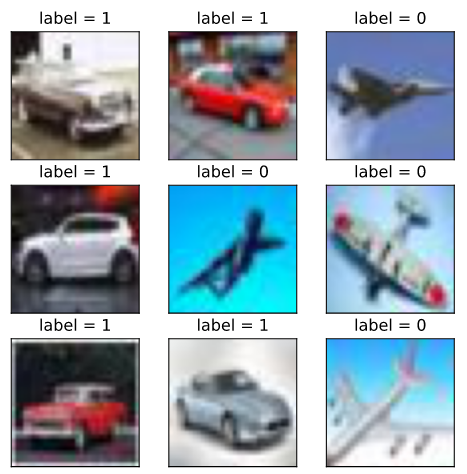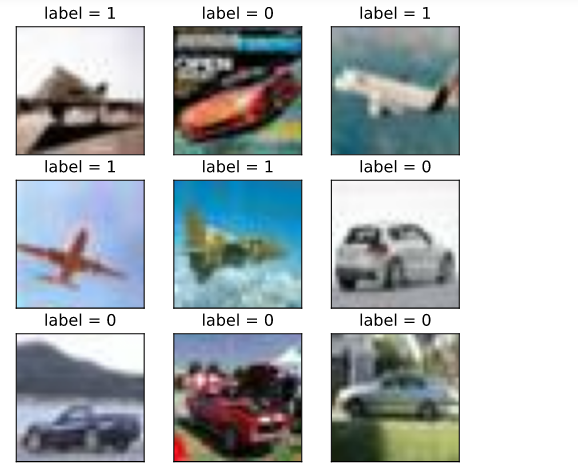5-1数据管道Dataset——eat_tensorflow2_in_30_days
5-1数据管道Dataset
如果需要训练的数据大小不大,例如不到1G,那么可以直接全部读入内存中进行训练,这样一般效率最高。 但如果需要训练的数据很大,例如超过10G,无法一次载入内存,那么通常需要在训练的过程中分批逐渐读入。
使用 tf.data API 可以构建数据输入管道,轻松处理大量的数据,不同的数据格式,以及不同的数据转换。
构建数据管道#
可以从 Numpy array, Pandas DataFrame, Python generator, csv文件, 文本文件, 文件路径, tfrecords文件等方式构建数据管道。
其中通过Numpy array, Pandas DataFrame, 文件路径构建数据管道是最常用的方法。
通过tfrecords文件方式构建数据管道较为复杂,需要对样本构建tf.Example后压缩成字符串写到tfrecoreds文件,读取后再解析成tf.Example。
但tfrecoreds文件的优点是压缩后文件较小,便于网络传播,加载速度较快。
- 从Numpy array构建数据管道
# 从Numpy ndarray构建数据管道
import tensorflow as tf
import numpy as np
from sklearn import datasets
iris = datasets.load_iris()
ds1 = tf.data.Dataset.from_tensor_slices((iris['data'], iris['target']))
for features, label in ds1.take(5):
print(features, label)
"""
tf.Tensor([5.1 3.5 1.4 0.2], shape=(4,), dtype=float64) tf.Tensor(0, shape=(), dtype=int64)
tf.Tensor([4.9 3. 1.4 0.2], shape=(4,), dtype=float64) tf.Tensor(0, shape=(), dtype=int64)
tf.Tensor([4.7 3.2 1.3 0.2], shape=(4,), dtype=float64) tf.Tensor(0, shape=(), dtype=int64)
tf.Tensor([4.6 3.1 1.5 0.2], shape=(4,), dtype=float64) tf.Tensor(0, shape=(), dtype=int64)
tf.Tensor([5. 3.6 1.4 0.2], shape=(4,), dtype=float64) tf.Tensor(0, shape=(), dtype=int64)
"""
- 从 Pandas DataFrame构建数据管道
# 从Pandas DataFrame构建数据管道
import tensorflow as tf
from sklearn import datasets
import pandas as pd
iris = datasets.load_iris()
dfiris = pd.DataFrame(iris['data'], columns=iris.feature_names)
ds2 = tf.data.Dataset.from_tensor_slices((dfiris.to_dict('list'), iris['target']))
for features, label in ds2.take(3):
tf.print(features, label)
"""
{'petal length (cm)': 1.4,
'petal width (cm)': 0.2,
'sepal length (cm)': 5.1,
'sepal width (cm)': 3.5} 0
{'petal length (cm)': 1.4,
'petal width (cm)': 0.2,
'sepal length (cm)': 4.9,
'sepal width (cm)': 3} 0
{'petal length (cm)': 1.3,
'petal width (cm)': 0.2,
'sepal length (cm)': 4.7,
'sepal width (cm)': 3.2} 0
"""
%pprint on
for features, label in ds2.take(3):
print(features, label)
"""
Pretty printing has been turned ON
{'sepal length (cm)': <tf.Tensor: shape=(), dtype=float32, numpy=5.1>, 'sepal width (cm)': <tf.Tensor: shape=(), dtype=float32, numpy=3.5>, 'petal length (cm)': <tf.Tensor: shape=(), dtype=float32, numpy=1.4>, 'petal width (cm)': <tf.Tensor: shape=(), dtype=float32, numpy=0.2>} tf.Tensor(0, shape=(), dtype=int64)
{'sepal length (cm)': <tf.Tensor: shape=(), dtype=float32, numpy=4.9>, 'sepal width (cm)': <tf.Tensor: shape=(), dtype=float32, numpy=3.0>, 'petal length (cm)': <tf.Tensor: shape=(), dtype=float32, numpy=1.4>, 'petal width (cm)': <tf.Tensor: shape=(), dtype=float32, numpy=0.2>} tf.Tensor(0, shape=(), dtype=int64)
{'sepal length (cm)': <tf.Tensor: shape=(), dtype=float32, numpy=4.7>, 'sepal width (cm)': <tf.Tensor: shape=(), dtype=float32, numpy=3.2>, 'petal length (cm)': <tf.Tensor: shape=(), dtype=float32, numpy=1.3>, 'petal width (cm)': <tf.Tensor: shape=(), dtype=float32, numpy=0.2>} tf.Tensor(0, shape=(), dtype=int64)
"""
- 从Python generator构建数据管道
# 从Python generator构建数据管道
import tensorflow as tf
import matplotlib.pyplot as plt
from tensorflow.keras.preprocessing.image import ImageDataGenerator
# 定义一个从文件找那个读取图片的generator
image_generator = ImageDataGenerator(rescale=1.0/255).flow_from_directory(
'./data/cifar2/test/',
target_size=(32, 32),
batch_size=20,
class_mode='binary'
)
classdict = image_generator.class_indices
print(classdict)
def generator():
for features, label in image_generator:
yield (features, label)
ds3 = tf.data.Dataset.from_generator(generator, output_types=(tf.float32, tf.int32))
"""
Found 2000 images belonging to 2 classes.
{'airplane': 0, 'automobile': 1}
"""
%matplotlib inline
%config InlineBackend.figure_format='svg'
plt.figure(figsize=(6, 6))
for i, (img, label) in enumerate(ds3.unbatch().take(9)):
ax = plt.subplot(3, 3, i+1)
ax.imshow(img.numpy())
ax.set_title('label = %d' % label)
ax.set_xticks([])
ax.set_yticks([])
plt.show()
- 从csv文件构建数据管道
# 从csv文件构建数据管道
ds4 = tf.data.experimental.make_csv_dataset(
file_pattern=['./data/titanic/train.csv', './data/titanic/test.csv'],
batch_size=3,
label_name='Survived',
na_value='',
num_epochs=1,
ignore_errors=True
)
for data, label in ds4.take(2):
tf.print(data, label)
"""
OrderedDict([('PassengerId', [32 2 41]),
('Pclass', ["" "" ""]),
('Name', ["S" "Q" "S"]),
('Sex', [8.3625 29.125 14.1083]),
('Age', ["Gronnestad, Mr. Daniel Danielsen" "Rice, Master. Eugene" "Hansen, Mr. Claus Peter"]),
('SibSp', [0 1 0]),
('Parch', [770 17 861]),
('Ticket', [3 3 3]),
('Fare', ["male" "male" "male"]),
('Cabin', [0 4 2]),
('Embarked', ["8471" "382652" "350026"])]) [0 0 0]
OrderedDict([('PassengerId', [0 14 42]),
('Pclass', ["" "" ""]),
('Name', ["Q" "S" "S"]),
('Sex', [15.5 7.8542 52]),
('Age', ["O\'Brien, Mrs. Thomas (Johanna \"Hannah\" Godfrey)" "Vestrom, Miss. Hulda Amanda Adolfina" "Holverson, Mr. Alexander Oskar"]),
('SibSp', [0 0 0]),
('Parch', [187 15 36]),
('Ticket', [3 3 1]),
('Fare', ["female" "female" "male"]),
('Cabin', [1 0 1]),
('Embarked', ["370365" "350406" "113789"])]) [1 0 0]
"""
- 从文本文件构建数据管道
# 从文本文件构建数据管道
ds5 = tf.data.TextLineDataset(
filenames=['./data/titanic/train.csv', './data/titanic/test.csv'],
).skip(1) # 略去第一行header
for line in ds5.take(5):
tf.print(line)
"""
493,0,1,"Molson, Mr. Harry Markland",male,55.0,0,0,113787,30.5,C30,S
53,1,1,"Harper, Mrs. Henry Sleeper (Myna Haxtun)",female,49.0,1,0,PC 17572,76.7292,D33,C
388,1,2,"Buss, Miss. Kate",female,36.0,0,0,27849,13.0,,S
192,0,2,"Carbines, Mr. William",male,19.0,0,0,28424,13.0,,S
687,0,3,"Panula, Mr. Jaako Arnold",male,14.0,4,1,3101295,39.6875,,S
"""
- 从文件路径构建数据管道
# 从文件路径构建数据管道
ds6 = tf.data.Dataset.list_files('./data/cifar2/train/*/*.jpg')
for file in ds6.take(5):
tf.print(file)
"""
./data/cifar2/train/automobile/964.jpg
./data/cifar2/train/airplane/2174.jpg
./data/cifar2/train/automobile/3573.jpg
./data/cifar2/train/automobile/781.jpg
./data/cifar2/train/automobile/902.jpg
"""
def load_image(img_path, size=(32, 32)):
label = 1 if tf.strings.regex_full_match(img_path, '.*/automobile/.*') else 0
img = tf.io.read_file(img_path)
img = tf.image.decode_jpeg(img) # 注意此处为jpeg格式
img = tf.image.resize(img, size)
return (img, label)
%matplotlib inline
%config InlineBackend.figure_format='svg'
for i, (img, label) in enumerate(ds6.map(load_image).take(2)):
plt.figure(i, figsize=(1, 1))
plt.imshow((img/255.0).numpy())
plt.title('label = %d' % label)
plt.xticks([])
plt.yticks([])
- 从tfrecords文件构建数据管道
# 从tf.records文件构建数据管道
import os
import numpy as np
# inpath:原始数据路径outpath:TFRecord文件输出路径
def create_tfrecords(inpath, outpath):
writer = tf.io.TFRecordWriter(outpath)
dirs = os.listdir(inpath)
for index, name in enumerate(dirs):
class_path = os.path.join(inpath, name)
for img_name in os.listdir(class_path):
img_path = os.path.join(class_path, img_name)
img = tf.io.read_file(img_path)
example = tf.train.Example(features=tf.train.Features(feature={
'label': tf.train.Feature(int64_list=tf.train.Int64List(value=[index])),
'img_raw': tf.train.Feature(bytes_list=tf.train.BytesList(value=[img.numpy()]))
}))
writer.write(example.SerializeToString())
writer.close()
create_tfrecords('./data/cifar2/test/', './data/cifar2_test.tfrecords/')
def parse_example(proto):
description = {
'img_raw': tf.io.FixedLenFeature([], tf.string),
'label': tf.io.FixedLenFeature([], tf.int64)
}
example = tf.io.parse_single_example(proto, description)
img = tf.image.decode_jpeg(example['img_raw']) # 注意此处为jpeg格式
img = tf.image.resize(img, (32, 32))
label = example['label']
return (img, label)
ds7 = tf.data.TFRecordDataset('./data/cifar2_test.tfrecords').map(parse_example).shuffle(3000)
%matplotlib inline
%config InlineBackend.figure_format = 'svg'
plt.figure(figsize=(6, 6))
for i, (img, label) in enumerate(ds7.take(9)):
ax=plt.subplot(3,3,i+1)
ax.imshow((img/255.0).numpy())
ax.set_title("label = %d"%label)
ax.set_xticks([])
ax.set_yticks([])
plt.show()
应用数据转换#
Dataset数据结构应用非常灵活,因为它本质上是一个Sequece序列,其每个元素可以是各种类型,例如可以是张量,列表,字典,也可以是Dataset。
Dataset包含了非常丰富的数据转换功能。
- map: 将转换函数映射到数据集每一个元素。
- flat_map: 将转换函数映射到数据集的每一个元素,并将嵌套的Dataset压平。
- interleave: 效果类似flat_map,但可以将不同来源的数据夹在一起。
- filter: 过滤掉某些元素。
- zip: 将两个长度相同的Dataset横向铰合。
- concatenate: 将两个Dataset纵向连接。
- reduce: 执行归并操作。
- batch : 构建批次,每次放一个批次。比原始数据增加一个维度。 其逆操作为unbatch。
- padded_batch: 构建批次,类似batch, 但可以填充到相同的形状。
- window :构建滑动窗口,返回Dataset of Dataset.
- shuffle: 数据顺序洗牌。
- repeat: 重复数据若干次,不带参数时,重复无数次。
- shard: 采样,从某个位置开始隔固定距离采样一个元素。
- take: 采样,从开始位置取前几个元素。
# map:将转换函数映射到数据集每一个元素
ds = tf.data.Dataset.from_tensor_slices(['hello world', 'hello China', 'hello ShenZhen'])
ds_map = ds.map(lambda x: tf.strings.split(x, ' '))
for x in ds_map:
tf.print(x)
tf.print(' ')
for x in ds_map:
print(x)
"""
["hello" "world"]
["hello" "China"]
["hello" "ShenZhen"]
tf.Tensor([b'hello' b'world'], shape=(2,), dtype=string)
tf.Tensor([b'hello' b'China'], shape=(2,), dtype=string)
tf.Tensor([b'hello' b'ShenZhen'], shape=(2,), dtype=string)
"""
# filter:过滤掉某些元素
ds = tf.data.Dataset.from_tensor_slices(['hello world', 'hello China', 'hello ShenZhen'])
# 找出含有字母a或S的元素
ds_filter = ds.filter(lambda x: tf.strings.regex_full_match(x, '.*[a|S].*'))
for x in ds_filter:
tf.print(x)
"""
hello China
hello ShenZhen
"""
# zip:将两个长度相同的Dataset横向铰合
ds1 = tf.data.Dataset.range(0, 3)
ds2 = tf.data.Dataset.range(3, 6)
ds3 = tf.data.Dataset.range(6, 9)
ds_zip = tf.data.Dataset.zip((ds1, ds2, ds3))
tf.print(ds_zip)
tf.print()
for x, y, z in ds_zip:
print('x=', x.numpy(), ',y=', y.numpy(), ',z=', z.numpy())
"""
<ZipDataset shapes: ((), (), ()), types: (tf.int64, tf.int64, tf.int64)>
x= 0 ,y= 3 ,z= 6
x= 1 ,y= 4 ,z= 7
x= 2 ,y= 5 ,z= 8
"""
# concatenate:将两个Dataset纵向连接
ds1 = tf.data.Dataset.range(0, 3)
ds2 = tf.data.Dataset.range(3, 6)
ds_concat = tf.data.Dataset.concatenate(ds1, ds2)
for x in ds_concat:
tf.print(x)
"""
0
1
2
3
4
5
"""
# reduce:执行归并操作
ds = tf.data.Dataset.from_tensor_slices([1, 2, 3, 4, 5.0])
result = ds.reduce(0.0, lambda x, y: tf.add(x, y))
tf.print(result)
"""
15
"""
# batch:构建批次,每次放一个批次。比原始数据增加一个维度。其你操作为unbatch
ds = tf.data.Dataset.range(12)
ds_batch = ds.batch(4)
for x in ds_batch:
print(x)
"""
# batch:构建批次,每次放一个批次。比原始数据增加一个维度。其你操作为unbatch
ds = tf.data.Dataset.range(12)
ds_batch = ds.batch(4)
for x in ds_batch:
print(x)
tf.Tensor([0 1 2 3], shape=(4,), dtype=int64)
tf.Tensor([4 5 6 7], shape=(4,), dtype=int64)
tf.Tensor([ 8 9 10 11], shape=(4,), dtype=int64)
"""
# padded_batch:构建批次,类似batch,但可以填充到相同的形状
elements = [[1, 2], [3, 4, 5], [6, 7], [8]]
ds = tf.data.Dataset.from_generator(lambda: iter(elements), tf.int32)
ds_padding_batch = ds.padded_batch(2, padded_shapes=[4,])
for x in ds_padding_batch:
print(x)
"""
tf.Tensor(
[[1 2 0 0]
[3 4 5 0]], shape=(2, 4), dtype=int32)
tf.Tensor(
[[6 7 0 0]
[8 0 0 0]], shape=(2, 4), dtype=int32)
"""
# window:构建滑动窗口,返回Dataset of Dataset
ds = tf.data.Dataset.range(12)
# window返回的是Dataset of Dataset,可以用flat_map压平
ds_window = ds.window(3, shift=1).flat_map(lambda x: x.batch(3, drop_remainder=True))
for x in ds_window:
print(x)
"""
tf.Tensor([0 1 2], shape=(3,), dtype=int64)
tf.Tensor([1 2 3], shape=(3,), dtype=int64)
tf.Tensor([2 3 4], shape=(3,), dtype=int64)
tf.Tensor([3 4 5], shape=(3,), dtype=int64)
tf.Tensor([4 5 6], shape=(3,), dtype=int64)
tf.Tensor([5 6 7], shape=(3,), dtype=int64)
tf.Tensor([6 7 8], shape=(3,), dtype=int64)
tf.Tensor([7 8 9], shape=(3,), dtype=int64)
tf.Tensor([ 8 9 10], shape=(3,), dtype=int64)
tf.Tensor([ 9 10 11], shape=(3,), dtype=int64)
"""
# shuffle:数据顺序洗牌
ds = tf.data.Dataset.range(12)
ds_shuffle = ds.shuffle(buffer_size=5)
for x in ds_shuffle:
print(x)
"""
tf.Tensor(1, shape=(), dtype=int64)
tf.Tensor(4, shape=(), dtype=int64)
tf.Tensor(6, shape=(), dtype=int64)
tf.Tensor(2, shape=(), dtype=int64)
tf.Tensor(7, shape=(), dtype=int64)
tf.Tensor(8, shape=(), dtype=int64)
tf.Tensor(10, shape=(), dtype=int64)
tf.Tensor(5, shape=(), dtype=int64)
tf.Tensor(0, shape=(), dtype=int64)
tf.Tensor(11, shape=(), dtype=int64)
tf.Tensor(3, shape=(), dtype=int64)
tf.Tensor(9, shape=(), dtype=int64)
"""
# repeat:重复数据若干次,不带参数时,重复无数次
ds = tf.data.Dataset.range(3)
ds_repeat = ds.repeat(3)
for x in ds_repeat:
print(x)
"""
f.Tensor(0, shape=(), dtype=int64)
tf.Tensor(1, shape=(), dtype=int64)
tf.Tensor(2, shape=(), dtype=int64)
tf.Tensor(0, shape=(), dtype=int64)
tf.Tensor(1, shape=(), dtype=int64)
tf.Tensor(2, shape=(), dtype=int64)
tf.Tensor(0, shape=(), dtype=int64)
tf.Tensor(1, shape=(), dtype=int64)
tf.Tensor(2, shape=(), dtype=int64)
"""
# shard:采样,从某个位置开始隔固定距离采样一个元素
ds = tf.data.Dataset.range(12)
ds_shard = ds.shard(3, index=1)
for x in ds_shard:
print(x)
"""
tf.Tensor(1, shape=(), dtype=int64)
tf.Tensor(4, shape=(), dtype=int64)
tf.Tensor(7, shape=(), dtype=int64)
tf.Tensor(10, shape=(), dtype=int64)
"""
# take:采样,从开始位置取前几个元素
ds = tf.data.Dataset.range(12)
ds_take = ds.take(3)
list(ds_take.as_numpy_iterator())
"""
[0, 1, 2]
"""
提升管道性能#
训练深度学习模型常常会非常耗时。
模型训练的耗时主要来自于两个部分,一部分来自数据准备,另一部分来自参数迭代。
参数迭代过程的耗时通常依赖于GPU来提升。
而数据准备过程的耗时则可以通过构建高效的数据管道进行提升。
以下是一些构建高效数据管道的建议。
- 1、使用 prefetch 方法让数据准备和参数迭代两个过程相互并行。
- 2、使用 interleave 方法可以让数据读取过程多进程执行,并将不同来源数据夹在一起。
- 3、使用 map 时设置num_parallel_calls 让数据转换过程多进行执行。
- 4、使用 cache 方法让数据在第一个epoch后缓存到内存中,仅限于数据集不大情形。
- 5、使用 map 转换时,先batch, 然后采用向量化的转换方法对每个batch进行转换。
- 使用 prefetch 方法让数据准备和参数迭代两个过程相互并行
import tensorflow as tf
#打印时间分割线
@tf.function
def printbar():
ts = tf.timestamp()
today_ts = ts%(24*60*60)
hour = tf.cast(today_ts//3600+8,tf.int32)%tf.constant(24)
minite = tf.cast((today_ts%3600)//60,tf.int32)
second = tf.cast(tf.floor(today_ts%60),tf.int32)
def timeformat(m):
if tf.strings.length(tf.strings.format("{}",m))==1:
return(tf.strings.format("0{}",m))
else:
return(tf.strings.format("{}",m))
timestring = tf.strings.join([timeformat(hour),timeformat(minite),
timeformat(second)],separator = ":")
tf.print("=========="*8,end = "")
tf.print(timestring)
import time
# 数据准备和参数迭代两个过程默认情况下是串行的
def generator():
for i in range(10):
# 假设每次准备数据需要2s
time.sleep(2)
yield i
ds = tf.data.Dataset.from_generator(generator, output_types=(tf.int32))
# 模拟参数迭代
def train_step():
time.sleep(1)
# 训练过程预计耗时:10*2 + 10*1 = 30s
printbar()
tf.print(tf.constant('start traing...'))
for x in ds:
train_step()
printbar()
tf.print(tf.constant('end training...'))
"""
================================================================================11:30:19
start traing...
================================================================================11:30:49
end training...
"""
# 使用prefetch方法让数据准备和参数迭代两个过程相互并行
# 训练过程预计耗时 max(10*2, 10*1) = 20s
printbar()
tf.print(tf.constant('start training with prefetch...'))
# tf.data.experimental.AUTOTUNE 可以让程序自动选择合适的参数
for x in ds.prefetch(buffer_size=tf.data.experimental.AUTOTUNE):
train_step()
printbar()
tf.print(tf.constant("end training..."))
"""
================================================================================11:33:31
start training with prefetch...
================================================================================11:33:52
end training...
"""
- 使用 interleave 方法可以让数据读取过程多进程执行,并将不同来源数据夹在一起
# 使用interleave方法可以让数据读取过程多进程执行,并将不同来源数据夹在一起
ds_files = tf.data.Dataset.list_files('./data/titanic/*.csv')
ds = ds_files.interleave(lambda x: tf.data.TextLineDataset(x).skip(1))
for line in ds.take(4):
print(line)
"""
tf.Tensor(b'493,0,1,"Molson, Mr. Harry Markland",male,55.0,0,0,113787,30.5,C30,S', shape=(), dtype=string)
tf.Tensor(b'181,0,3,"Sage, Miss. Constance Gladys",female,,8,2,CA. 2343,69.55,,S', shape=(), dtype=string)
tf.Tensor(b'53,1,1,"Harper, Mrs. Henry Sleeper (Myna Haxtun)",female,49.0,1,0,PC 17572,76.7292,D33,C', shape=(), dtype=string)
tf.Tensor(b'405,0,3,"Oreskovic, Miss. Marija",female,20.0,0,0,315096,8.6625,,S', shape=(), dtype=string)
"""
ds_files = tf.data.Dataset.list_files('./data/titanic/*.csv')
ds = ds_files.flat_map(lambda x: tf.data.TextLineDataset(x).skip(1))
for line in ds.take(4):
print(line)
"""
tf.Tensor(b'181,0,3,"Sage, Miss. Constance Gladys",female,,8,2,CA. 2343,69.55,,S', shape=(), dtype=string)
tf.Tensor(b'405,0,3,"Oreskovic, Miss. Marija",female,20.0,0,0,315096,8.6625,,S', shape=(), dtype=string)
tf.Tensor(b'635,0,3,"Skoog, Miss. Mabel",female,9.0,3,2,347088,27.9,,S', shape=(), dtype=string)
tf.Tensor(b'701,1,1,"Astor, Mrs. John Jacob (Madeleine Talmadge Force)",female,18.0,1,0,PC 17757,227.525,C62 C64,C', shape=(), dtype=string)
"""
- 使用 map 时设置num_parallel_calls 让数据转换过程多进行执行
ds = tf.data.Dataset.list_files('./data/cifar2/train/*/*.jpg')
def load_imagee(img_path, size=(32, 32)):
label = 1 if tf.strings.regex_full_match(img_path, '.*/automobile/.*') else 0
img = tf.io.read_file(img_path)
img = tf.image.decode_jpeg(img) # 注意此处为jpeg格式
img = tf.image.resize(32, 32)
return (img, label)
# 单进程转换
printbar()
tf.print(tf.constant('start transformation...'))
ds_map = ds.map(load_image)
for _ in ds_map:
pass
printbar()
tf.print(tf.constant('end transformation...'))
"""
================================================================================11:50:11
start transformation...
================================================================================11:50:13
end transformation...
"""
# 多进程转换
printbar()
tf.print(tf.constant('start transformation...'))
ds_map_parallel = ds.map(load_image, num_parallel_calls=tf.data.experimental.AUTOTUNE)
for _ in ds_map_parallel:
pass
printbar()
tf.print(tf.constant("end parallel transformation..."))
"""
================================================================================11:51:29
start transformation...
================================================================================11:51:29
end parallel transformation...
"""
- 使用 cache 方法让数据在第一个epoch后缓存到内存中,仅限于数据集不大情形
# 使用cache方法让数据在第一个epoch后缓存到内存中,仅限于数据集不大情形
import time
# 模拟数据准备
def generator():
for i in range(5):
# 假设每次准备数据需要2s
time.sleep(2)
yield i
ds = tf.data.Dataset.from_generator(generator, output_types=tf.int32)
# 模拟参数迭代
def train_step():
# 假设每一步训练需要0s
pass
# 训练过程预计耗时 (5*2 + 5*0) * 3 = 30s
printbar()
tf.print(tf.constant('start training...'))
for epoch in tf.range(3):
for x in ds:
train_step()
printbar()
tf.print('epoch=', epoch, 'ended')
printbar()
tf.print(tf.constant("end training..."))
"""
================================================================================12:59:01
start training...
================================================================================12:59:11
epoch= 0 ended
================================================================================12:59:21
epoch= 1 ended
================================================================================12:59:31
epoch= 2 ended
================================================================================12:59:31
end training...
"""
import time
# 模拟数据准备
def generator():
for i in range(5):
#假设每次准备数据需要2s
time.sleep(2)
yield i
# 使用cache方法让数据在第一个epoch后缓存到内存中,仅限于数据集不大情形
ds = tf.data.Dataset.from_generator(generator, output_types=tf.int32).cache()
# 模拟参数迭代
def train_step():
#假设每一步训练需要0s
time.sleep(0)
# 训练过程预计耗时(5*2 + 5*0) + (5*0+5*0)*2 = 10s
printbar()
tf.print(tf.constant("start training..."))
for epoch in tf.range(3):
for x in ds:
train_step()
printbar()
tf.print("epoch =",epoch," ended")
printbar()
tf.print(tf.constant("end training..."))
"""
================================================================================13:05:12
start training...
================================================================================13:05:22
epoch = 0 ended
================================================================================13:05:22
epoch = 1 ended
================================================================================13:05:22
epoch = 2 ended
================================================================================13:05:22
end training...
"""
- 使用 map转换时,先batch, 然后采用向量化的转换方法对每个batch进行转换
# 使用map转换时,先batch,然后采用向量化的转换方法对每个batch进行转换
ds = tf.data.Dataset.range(100000)
ds_map_batch = ds.map(lambda x: x**2).batch(20)
printbar()
tf.print(tf.constant('start scaler transformation...'))
for x in ds_map_batch:
pass
printbar()
tf.print(tf.constant('end scaler transformation'))
"""
================================================================================13:09:18
start scaler transformation...
================================================================================13:09:19
end scaler transformation
"""
# 先batch后map
ds = tf.data.Dataset.range(100000)
ds_batch_map = ds.batch(20).map(lambda x: x**2)
printbar()
tf.print(tf.constant('start vector transformation...'))
for x in ds_batch_map:
pass
printbar()
tf.print(tf.constant("end vector transformation..."))
"""
================================================================================13:12:05
start vector transformation...
================================================================================13:12:05
end vector transformation...
"""
作者:lotuslaw
出处:https://www.cnblogs.com/lotuslaw/p/16413389.html
版权:本作品采用「署名-非商业性使用-相同方式共享 4.0 国际」许可协议进行许可。







【推荐】国内首个AI IDE,深度理解中文开发场景,立即下载体验Trae
【推荐】编程新体验,更懂你的AI,立即体验豆包MarsCode编程助手
【推荐】抖音旗下AI助手豆包,你的智能百科全书,全免费不限次数
【推荐】轻量又高性能的 SSH 工具 IShell:AI 加持,快人一步
· 阿里最新开源QwQ-32B,效果媲美deepseek-r1满血版,部署成本又又又降低了!
· 开源Multi-agent AI智能体框架aevatar.ai,欢迎大家贡献代码
· Manus重磅发布:全球首款通用AI代理技术深度解析与实战指南
· 被坑几百块钱后,我竟然真的恢复了删除的微信聊天记录!
· 没有Manus邀请码?试试免邀请码的MGX或者开源的OpenManus吧